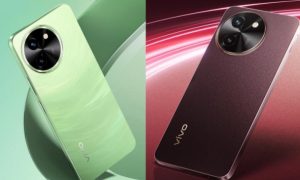A couple of years ago, the smartphone industry was struck by the selfie frenzy, and pretty much every manufacturer began selling selfie-focused models. Among the crowd, Oppo’s F series and Vivo’s V series have stood the test of time, as both companies continue to iterate and refresh them.
Vivo’s latest offering is the V11 Pro, an iterative update to the Vivo V9 (Review) which was launched about six months ago. This is the first V series phone to sport an in-display fingerprint sensor, which debuted on the Vivo X21 (Review). In many ways, the V11 Pro is like a selfie-centric version of the X21, and apart from the fingerprint sensor, it also has similar specifications as its higher-end sibling.
Priced at Rs. 25,990, does the V11 Pro have enough to differentiate itself from its rivals? Let’s find out.
Vivo V11 Pro design
Given the fact that there’s only been a short interval between the launches of the Vivo V9 and V11 Pro, it’s no surprise that the new model looks pretty much identical to its predecessor. The buttons, SIM tray, ports, and even the rear camera module have virtually identical placements. This phone is also very light thanks to its all-plastic body, and is easy to manage with one hand. It’s as thick as the V9, at 7.9mm, but is slightly taller, so it might feel more bulky in your pocket. The glossy back also attracts smudges very easily.
The larger body makes room for a bigger display, which measures 6.41 inches diagonally. Vivo is calling this a ‘Halo FullView’ display since it has slim borders on all sides and a really tiny notch. The latter is similar to what we just saw on the Oppo F9 Pro (Review). Since there’s only room for the front camera, the sensors have been moved into the edge of the bezel to the right of the camera, while the earpiece is cleverly placed just above it. The V11 Pro comes with a screen protector pre-installed, but it also has Gorilla Glass 3 reinforcement.
The display has a healthy full-HD+ resolution which brings the total pixel count to just over 400ppi. Images and text look sharp, and the Super AMOLED panel ensures vivid colours and deep backs. The AMOLED panel is a prerequisite for having an in-display fingerprint sensor. You now get the option to select from three different animation styles for the authentication process.
A fingerprint logo lights up when motion is detected so you know where to place your finger, but authentication isn’t very quick. It takes a full second or two before the phone unlocks. In contrast, face recognition was lightning quick, and worked well for us even under low light. It doesn’t work if your eyes are closed, which makes it a little more secure. For added safety, you can opt for a combination of face and fingerprint authentication.
The V11 Pro gets some new colour options. Our unit had a dual-tone finish called Starry Night, with a black upper half that transitions into a glittery blue lower half. This phone is also available in Dazzling Gold. In the box, you get a silicone case, a SIM eject tool, a headset, a Micro-USB cable, and a fast-charge capable power adapter.
Vivo V11 Pro specifications and software
The Vivo V11 Pro is powered by the Qualcomm Snapdragon 660 mobile platform, and has 6GB of RAM, just like the Vivo X21. Most of this phone’s benchmark numbers were a bit lower compared to the X21, and AnTuTu wouldn’t run to completion, so we couldn’t get a score. The phone has 64GB of storage, which is expandable by up to 256GB. You also get dual-band Wi-Fi 802.11ac, Bluetooth 5, USB-OTG, GPS, and FM radio, but no NFC. Sensors include an ambient light sensor, virtual gyroscope, proximity sensor, and a compass.
To compensate for the lack of a notification LED, you can enable the always-on display, which shows you the time, date, battery level, and app icons for any incoming notifications. However, the notifications are passive, which means you can’t interact with them the way Samsung and many others allow. You also don’t get any controls on the always-on display when music is playing.
Vivo’s Funtouch OS is now at version 4.5, and is based on Android 8.1 Oreo. It’s quite different from stock Android so there is a learning curve if this is your first Vivo phone. The leftmost home screen is dedicated to the Smart Launcher, which shows you calendar events, the weather, a step counter, and shortcuts for your favourite apps. You can change the theme using the iTheme app and download apps from Vivo’s own app store. There are plenty of preinstalled apps too, such as NewsPoint, UC Browser, social media apps, and WPS Office. These can be removed if you don’t want them.
The Control Centre window, which you access by swiping upwards from the bottom of the display, has a toggle for Bike mode. With this, you can filter out which calls to accept or reject and also respond to them with a custom SMS. Jovi is Vivo’s AI engine, which works across a couple of different usage scenarios. Within the camera app, there’s automatic beautification in selfies as well as object and scene detection. It’s also found in the Smart Launcher, where it prompts you with nearby events or weather information based on your location. Finally, there’s Game mode, which gives you toggles within a game for muting notifications, auto-rejecting incoming calls, etc. You also get a whole bunch of motion gestures, a one-handed mode, scrolling screenshots, and the ability to clone certain apps.
The OS is definitely feature-rich but it still has some of the same quirks we’ve pointed out in the past few versions. There’s a universal search function on the home screen, but we still don’t have one for the Settings app. The fact that the items within the Settings app have been moved around makes it difficult to find what you’re looking for. There’s also a mysterious bug in the Settings app that for some reason shows the word ‘Hovered’ on screen when you try to swipe downwards to scroll.
Vivo hasn’t given users any way to mask the area around the notch. In games, the prominent curves of the edges often obscure content, and if you don’t have a game running fullscreen in landscape mode, it will look flat on one side and rounded on the other, which is quite awkward. We see a new version of Funtouch OS with nearly every new phone that Vivo releases, but the company doesn’t seem to be paying attention to these little details. As a result, the software continues to feel a bit unpolished.
Finally, the V11 Pro also has something called FunMoji, which can be accessed through the TouchPal keyboard. It’s the closest we’ve see to Apple’s Animoji in terms of the quality of characters, but it doesn’t pick up subtle expressions and the tracking still is a bit jerky.
Vivo V11 Pro performance, cameras, and battery life
The heavy customisations to Android thankfully haven’t taken a toll on performance. The interface is snappy, and multitasking is handled very well. The display has very good touch response, although it does wash out a little under direct sunlight. We didn’t encounter any heating issues when using the GPS or downloading apps, but this phone does get fairly warm with a lot of camera use and when playing taxing games. Speaking of games, the Snapdragon 660 doesn’t have the best GPU, which is why titles like PUBG and Asphalt 9: Legends run at medium to low settings by default. Bumping up the graphics in PUBG caused a bit of stutter in gameplay, and Asphalt 9 had terrible jagged edges even with the graphics forced to the ‘High’ preset.
The primary rear camera has a 12-megapixel sensor and f/1.8 aperture lens. It supports dual pixel autofocus but doesn’t have optical stabilisation. Just like the X21, the V11 Pro locked focus very quickly without any hunting issues. Even when panning or shifting focus between subjects, it locked focus nearly instantaneously. This slowed down a bit in very low light, but not by much. The Auto HDR worked very well too, balancing the exposure of dark and bright areas well.
There was also no perceptible shutter lag under good light, which made shooting challenging subjects like pets a bit easier. The detail level and colours in landscapes were very good, and close-ups had a smooth bokeh effect. Noise was handled very well in low light too, while preserving details even in objects at a great distance.
The quality of 4K video recorded under natural light was good, but it got a little grainy in low light. Video resolutions are a bit limited, as your only other choices are 1080p and 720p. There’s nothing in between, like a 60fps mode. One feature that we really missed was electronic stabilisation, which we hope is addressed through an update in the future. The second 5-megapixel sensor is used for gauging depth. This kicks in when you switch to bokeh mode. You can vary the effective aperture through software, but edge detection wasn’t great.
The 25-megapixel selfie camera is still one of the best we’ve seen in this segment. Images are sharp and well exposed, and you get to play around with a couple of lighting modes similar to what the iPhone X offers. The AIFace Beauty shooting mode automatically applies filters, which can be manually tweaked if they are not to your liking. AR stickers are fun to play around with too.
The camera app is easy to master but the layout isn’t perfect. It takes a while to get to the shooting mode you want, as you need to swipe through each one and wait for the viewfinder to adapt to that mode before you can move to the next. Secondly, when shooting in landscape mode, the camera settings don’t switch orientation, which is really annoying. AI scene recognition can figure out a bunch of different objects and scenes but it takes a while. We didn’t notice much of a difference in image quality with it on or off. The AI Portrait Framing feature is handy for novice users, as it prompts you to reposition the camera if your subject is not in the centre of the frame.
Heavy camera use does drain the battery quickly but otherwise, with regular usage, we easily managed to get through an entire day or a bit more. A single round of PUBG, which typically lasts about 30 minutes, knocked 11 percent off the battery meter. The phone supports Vivo’s Dual Engine fast charging technology which gives you roughly a 42 percent charge in 30 minutes, and around 80 percent in an hour. This seems to be based on Qualcomm’s Quick Charge technology, as the phone charges quickly when connected to a Quick Charge-compatible adapter.
Verdict
The Vivo V11 Pro is a solid all-rounder at Rs. 25,990 and offers better value than the Oppo F9 Pro (Review), but for a bit more money. Think of it as a Vivo X21 with a bigger battery and better front camera, but at a much more reasonable price, which is a good recipe. Obviously, it’s hard to ignore the Poco F1 (Review) at this price level, but getting your hands on one is likely to be difficult for a while, whereas the V11 Pro should have better online and offline availability. Then there’s the Nokia 7 Plus (Review) — a phone that has very similar specifications as the V11 Pro, but with the allure of stock Android One and much better construction quality.
There are some aspects of the Vivo V11 Pro that we wish were different. A USB Type-C port would have been preferable, the in-display fingerprint sensor still feels a bit sluggish, electronic stabilisation is missing, and the custom OS could use more polish.
Overall, though, the V11 Pro offers a good mix of features and performance at a competitive price.
For more updates: Like us on Facebook and follow us on Twitter & Instagram




































